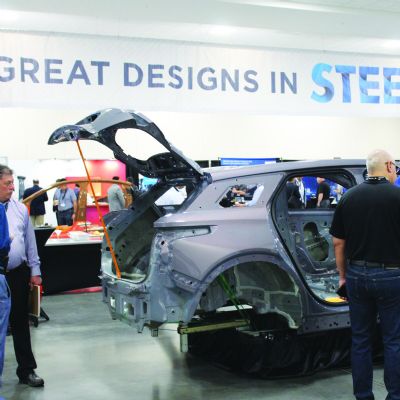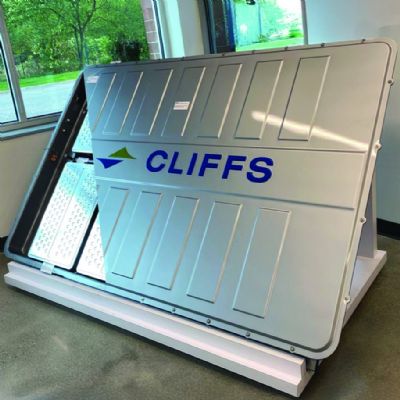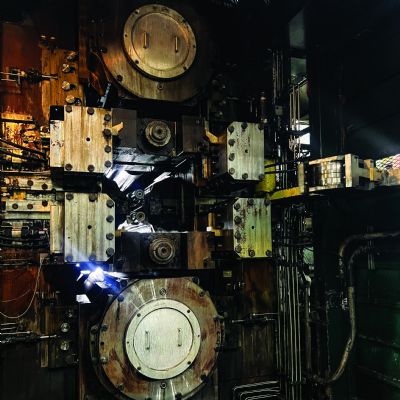“Testing absolutely is worthwhile, but the material must be available early enough in the tool-design phase,” Seekman says, noting that tensile testing may not be an option given the short lead time required on some projects. In such cases, simulation can provide a workaround.
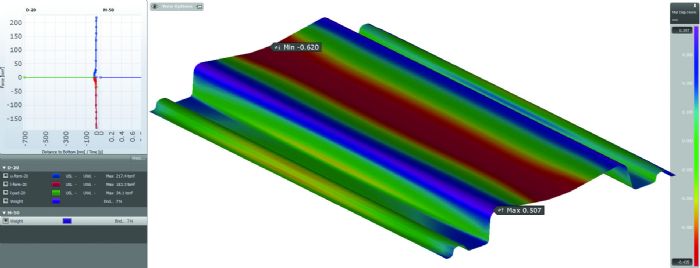 With simulation only performing as well as the quality of inputs, improper assessment of material—or material that falls out of requirements in various parts of a coil—makes AHSS applications even more challenging.
With simulation only performing as well as the quality of inputs, improper assessment of material—or material that falls out of requirements in various parts of a coil—makes AHSS applications even more challenging.
For example, the Die Cad team recalls a recent stamping customer suddenly experiencing excessive part cracking, leading to excessive scrap. Prior to any tool modifications, samples were sent for testing to learn whether the material left on the coil still was in the needed properties range.
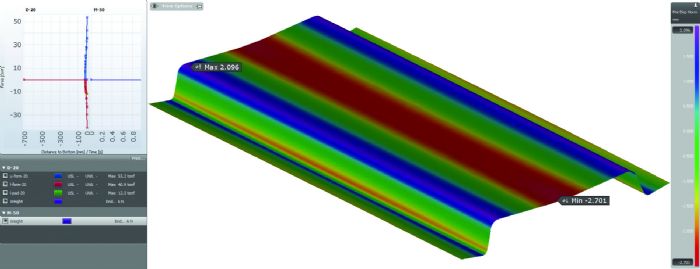 For those responsible for die tryout, the team offers, that may mean paying more money for expedited orders and the need to upgrade to more-refined material. Here again, this may be the only choice.
For those responsible for die tryout, the team offers, that may mean paying more money for expedited orders and the need to upgrade to more-refined material. Here again, this may be the only choice.
Where Simulation Shines
Not enough information exists on properties and forming attributes for some of these advanced materials, offers the team, citing the importance of feedback from die shops performing physical tryouts. Such feedback lets designers know if they are correlating simulation software to match the reality of what happens in the press, and adds to the AHSS-forming knowledge base.
Through this feedback and the ever-improving nature of simulation software, Die Cad has learned via draw applications with some of its stamping and die-build customers the importance of lock-bead construction to assist with forming action. This helps in providing extra tension or stretch at the end of a press stroke, given the difficulty in trying to get any pull on the hard AHSS.
However, features such as lock-bead construction result in added scrap, which increase material usage. Tool shops and stampers, the Die Cad team explains, face difficulties in these cases, as they must stay competitive with piece prices even though the process to properly make a part requires additional material for stretching, forming and retrimming that was not orginally quoted for.
Another challenge: Stampers may apply overcrowning—deforming material in the opposite direction as springback to achieve compensation. Extra hits can work-harden AHSS, making forming a specified radius an impossible task. Planning for AHSS formability and springback compensation is crucial, and zeroing in on compensation sometimes remains quite the challenge.
And, in the past few years simulation software has developed modules that help address press deflection, in part caused by higher pressure-pad forces required for forming AHSS, according to the Die Cad team.
One project involved such a scenario. The amount of die-pad deflection on very thick material stock deflected a 6-in. binder so much that the part would not form as expected. The solution involved re-engineering to allow for that press deflection. A simulation-software module shows the deflection, with Die Cad adding in thicker plates and seeing how much they deflect in order to limit press deflection. Shut height can’t be expanded, and the die plates that nitrogen cylinders hit against can’t be any thicker. Thus designers are pushing the comfort levels as to the amount of pressure applied to a 2-in.-thick die plate, for example.
Tackling Heat Transfer and Bend Radii
Running a progressive die over and over results in heat transfer from the forming reaction that can change the part output. Such predictions are in early development, Die Cad Group reports, noting that development and correlation between simulation software and the shop floor still is needed to better understand what can be obtained to improve end results.
AHSS also tests the ability to achieve a specified bend radius. Quite often, parts are designed with unrealistic radii—quickly proven unmakeable in simulation.
OEMs have begun defining required radii, and here simulation can prove effective—pointing out where an improper radius for the forming task of a defined material will fail, leading to redesign with proper radii. The Die Cad team agrees that an increase in such provided specs would go a long way toward heading off problems during tool design to ensure ideal forming results, with formable radii specified from the start. Such standards would lead to formable AHSS-part designs that don’t require redesigns, thus saving on lead time and project cost.
Simulation also can prove its worth in other press-related forming aspects. For example, one Die Cad Group customer, shopping for a mechanical press, seeking the amount of energy required to keep the flywheel turning in certain high-force applications without stopping. Simulation can determine the press energy required at various stages of the pendulum swing.
Better Sim: Understanding and Communication Needed
Given the correct material information, simulation offers valuable upfront predictions and solutions for properly forming a part. Simply using a blank-unfold simulation software to unfold parts and obtain minimum blank dimensions proves insufficient for advanced steels. While effective for simple parts from materials such as mild steel, this approach presents difficulties when dealing with AHSS. The key: Obtain enough stretch in the material, at the right time, in order to set its shape. Often, doing so requires added features, which, in turn, increase blank size. Advanced steels require special considerations related to press and line-equipment selection, proper holding of the material while forming, springback, the effects of work hardening and much more.
Overall, using simulation software at a project’s onset to determine feasibility, material usage, required concessions, springback compensation and tool-processing requirements is key to tool-build cost savings and success. Your wallet, and the customer, will thank you. MF
View Glossary of Metalforming Terms
See also: Die Cad Group LLC, American Iron and Steel Institute







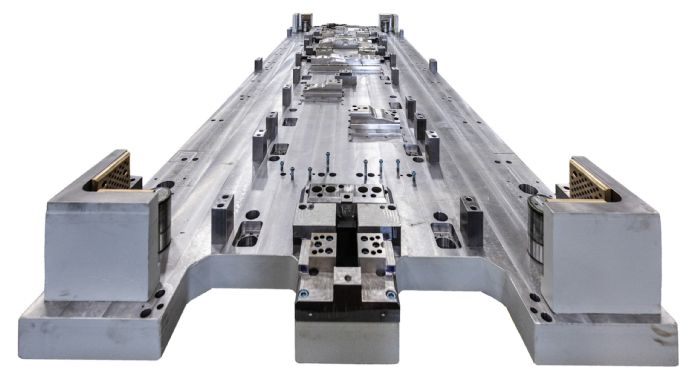 Roughly three decades ago, the first generation of AHSS appeared. Owing to multiphase microstructures, this class exhibited greater formability than existing high-strength low-alloy steels at similar strengths. Dual-phase (DP) steel, a first-generation AHSS, remains the most widely used globally. Second-generation AHSS followed with significantly increased formability and elongation compared to its predecessor. Unfortunately, high alloy content and a limited supply base often make second-generation AHSS an expensive proposition. These early AHSS generations still find great use in automotive safety, strength and lightweighting applications.
Roughly three decades ago, the first generation of AHSS appeared. Owing to multiphase microstructures, this class exhibited greater formability than existing high-strength low-alloy steels at similar strengths. Dual-phase (DP) steel, a first-generation AHSS, remains the most widely used globally. Second-generation AHSS followed with significantly increased formability and elongation compared to its predecessor. Unfortunately, high alloy content and a limited supply base often make second-generation AHSS an expensive proposition. These early AHSS generations still find great use in automotive safety, strength and lightweighting applications.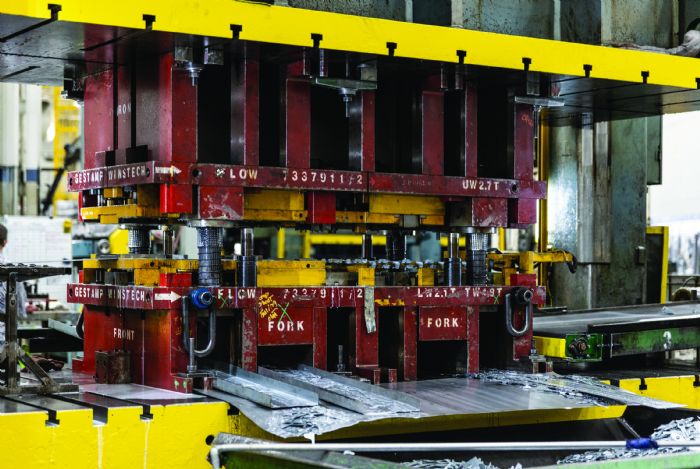 All through the AHSS evolution, these steels have tested those tasked with forming them, and those responsible for designing, building and maintaining required tooling. What are the challenges, and how are these challenges met? To learn more, MetalForming explored the topic, focusing primarily on simulation, with the stamping and tooling experts from Tooling Tech Group company Die Cad, a designer/engineer of stamping dies.
All through the AHSS evolution, these steels have tested those tasked with forming them, and those responsible for designing, building and maintaining required tooling. What are the challenges, and how are these challenges met? To learn more, MetalForming explored the topic, focusing primarily on simulation, with the stamping and tooling experts from Tooling Tech Group company Die Cad, a designer/engineer of stamping dies.